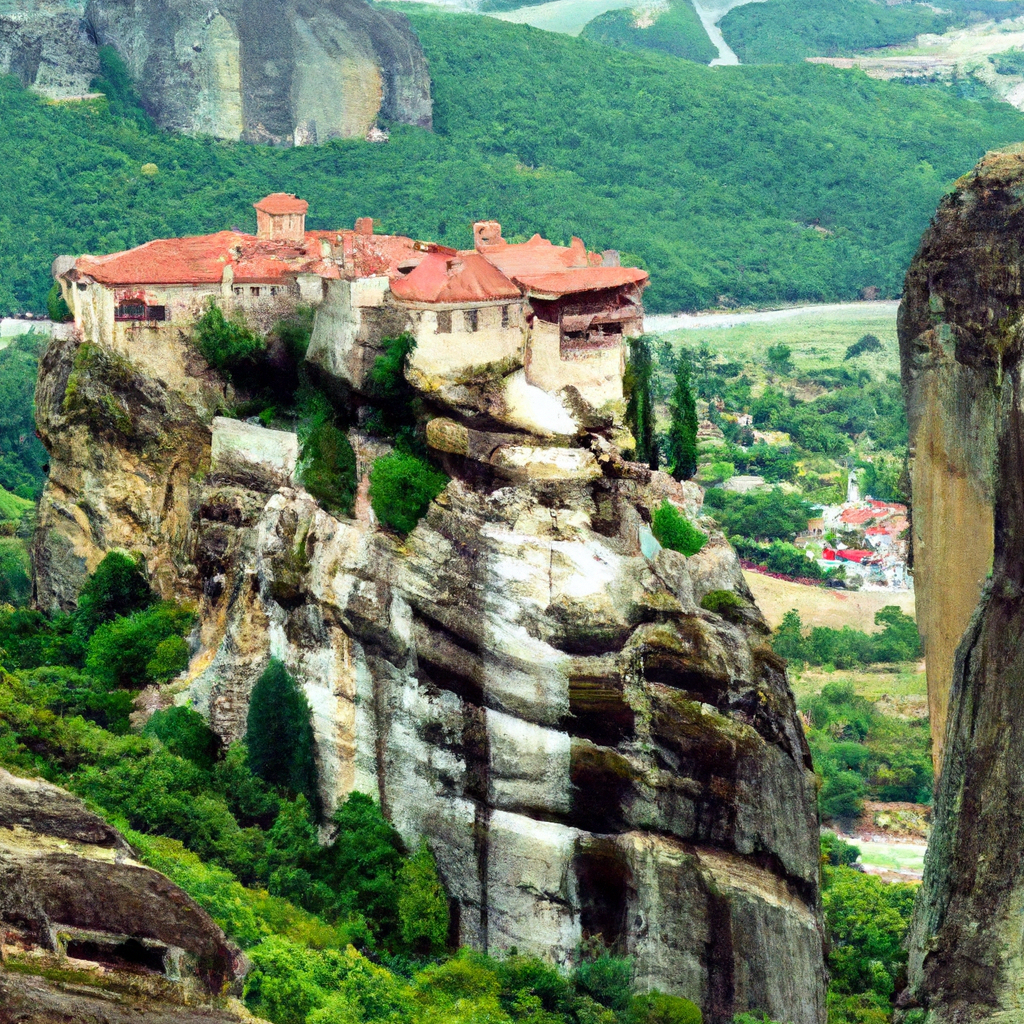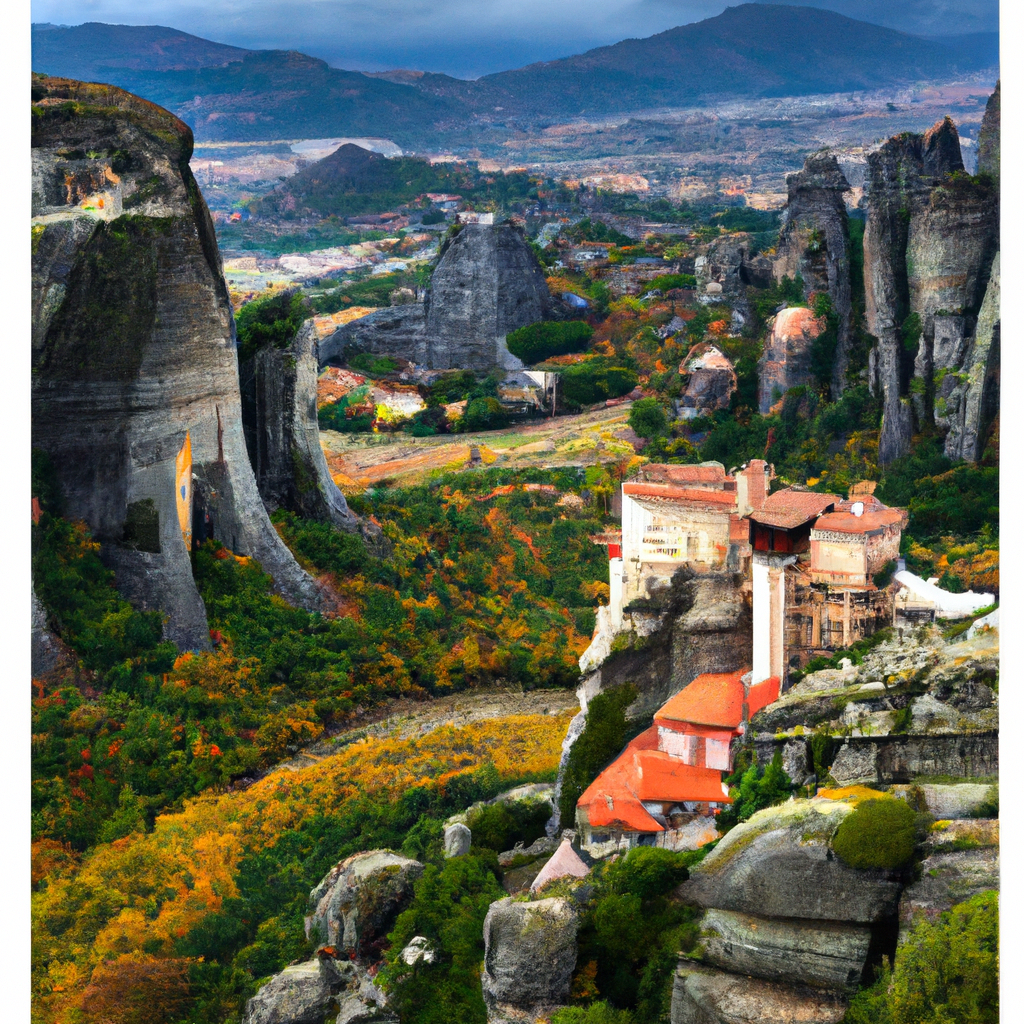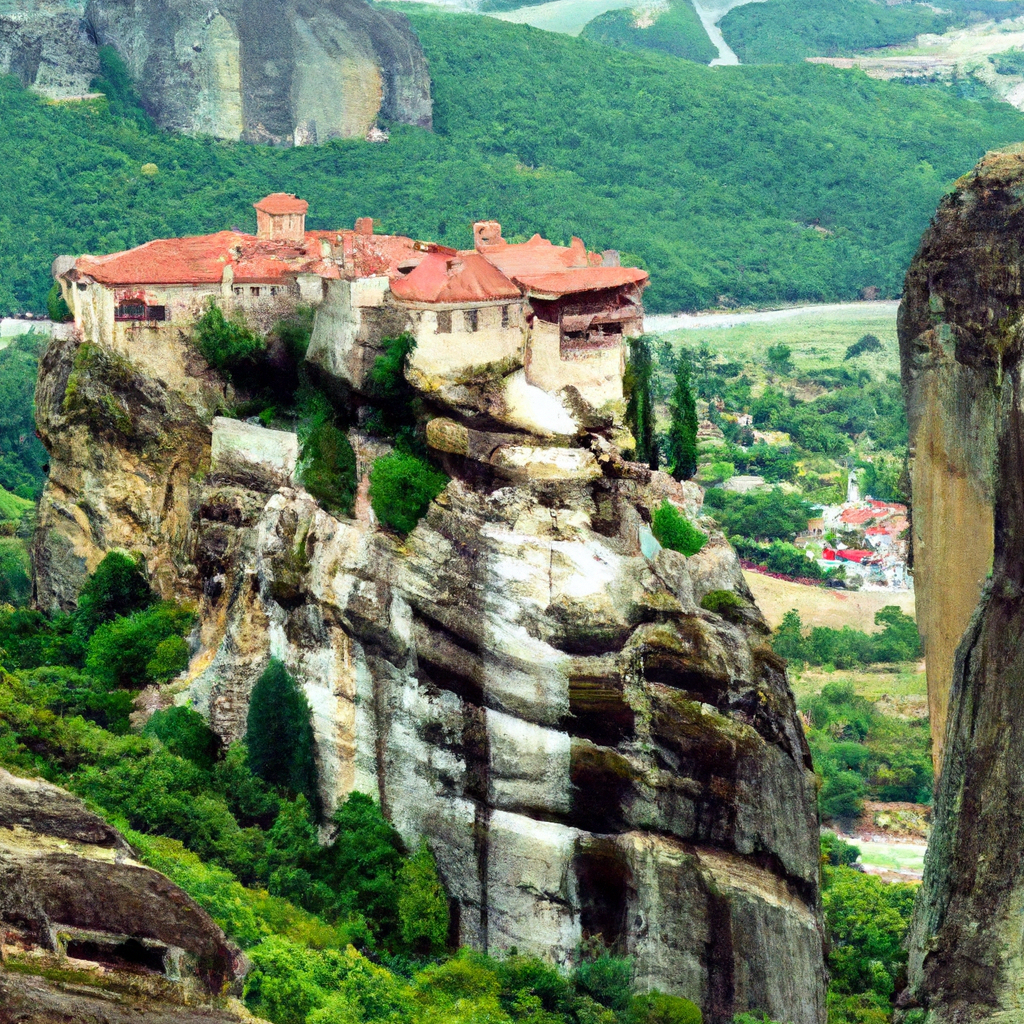Imagine yourself standing atop towering cliff formations, surrounded by a serene landscape that seems almost otherworldly. This is the mystic beauty of Meteora, a UNESCO World Heritage Site in Greece, known for its ancient monasteries perched precariously on rocky pillars. In this article, we will take you on a virtual journey to explore the fascinating history, breathtaking views, and spiritual allure of the monasteries of Meteora. Get ready to be captivated by an enchanting destination that combines nature’s magnificence with mankind’s devotion.
The History of Meteora
Ancient Origins
Meteora, located in central Greece, has a rich history that dates back thousands of years. Its name, which means “suspended in the air” in Greek, perfectly describes the awe-inspiring rock formations on which the monasteries are built. These rock pillars were formed millions of years ago through a combination of geological processes, including tectonic movements and weathering.
The Rise of Monasticism
In the 9th century, a group of hermit monks were drawn to the isolated and inaccessible rock formations of Meteora. Seeking a place of solitude and spiritual contemplation, they established the first monastic communities in the area. These early monks lived in caves or small cells carved into the rocks, living a life of prayer, meditation, and simplicity.
The Construction of the Monasteries
As the monastic communities grew, the monks realized the need for more permanent structures to house their religious activities. Starting in the 14th century, the construction of the monasteries began. Building materials were hauled up the steep cliffs using ropes, pulleys, and sheer determination. The monasteries were primarily constructed using local materials such as stone and wood, blending harmoniously with the natural environment.
The Geography of Meteora
Awe-Inspiring Rock Formations
One of the main attractions of Meteora is its stunning rock formations. These towering pillars of rock reach heights of up to 400 meters and are composed of conglomerate, sandstone, and shale. Over time, erosion and weathering sculpted these rocks into unique and breathtaking shapes, providing a dramatic backdrop for the monasteries.
Natural Beauty of the Surroundings
The surreal beauty of Meteora extends beyond the rock formations. The area is surrounded by lush valleys, flowing rivers, and picturesque landscapes. The lush greenery of the Pindus Mountains contrasts with the ruggedness of the rock pillars, creating a serene and harmonious environment. Visitors can explore the many hiking trails and enjoy the natural beauty that Meteora has to offer.
Getting to Meteora
By Plane
The nearest airport to Meteora is the Thessaloniki International Airport, located approximately 230 kilometers away. From the airport, you can take a taxi or a bus to the city of Kalambaka, which serves as the gateway to Meteora. Several airlines offer domestic and international flights to Thessaloniki, making it a convenient option for travelers.
By Train
Traveling by train is another popular option for reaching Meteora. The train station in Kalambaka is well-connected to major cities in Greece, including Athens and Thessaloniki. The journey by train provides scenic views of the countryside, allowing you to immerse yourself in the beauty of the Greek landscape.
By Car
For those who prefer to drive, Meteora is easily accessible by car. The E92 highway connects the area with major cities in Greece, making it a convenient and flexible option. However, it’s important to note that the roads leading to Meteora can be winding and steep, so cautious driving is advised.
Visiting the Monasteries

Monastery Etiquette
When visiting the monasteries of Meteora, it’s important to respect the religious significance of these sacred sites. Modest attire is required, with men advised to wear long pants and women to cover their shoulders and legs. Photography may be restricted in certain areas, so it’s best to check with the monastery before taking photos. It’s also important to keep noise to a minimum and refrain from touching any religious artifacts.
Monastery Opening Hours
Each monastery has its own opening hours, so it’s advisable to plan your visit accordingly. Generally, the monasteries open in the morning and close in the early afternoon, with a break for lunch. It’s best to arrive early to avoid large crowds and ensure a peaceful experience.
Tour Options
While it is possible to explore Meteora independently, guided tours are available for those who prefer a more structured experience. These tours provide valuable insights into the history and significance of the monasteries, as well as access to areas that may be off-limits to individual visitors. Additionally, the knowledgeable guides can offer interesting anecdotes and stories that bring the monastic life to life.
The Monastery of Great Meteoron
A Brief Overview
The Monastery of Great Meteoron, also known as the Holy Monastery of Transfiguration, is the largest and oldest of the monasteries in Meteora. Founded in the mid-14th century, it served as a haven for monks seeking spiritual enlightenment. Today, it stands as a testament to the perseverance and dedication of the early founders.
Architectural Features
The Monastery of Great Meteoron showcases a unique blend of Byzantine, Venetian, and Ottoman architectural styles. Its imposing façade, adorned with intricate carvings and Byzantine frescoes, is a sight to behold. As you explore the monastery, you’ll come across courtyards, chapels, and a small museum housing religious artifacts and manuscripts.
Religious Artworks
The interior of the Monastery of Great Meteoron is adorned with stunning religious artworks. Byzantine frescoes, dating back centuries, cover the walls and ceilings, depicting scenes from the Bible and the lives of saints. Iconostases, intricately carved wooden screens, separate the nave from the sanctuary, showcasing the craftsmanship of the medieval artisans.
The Monastery of Varlaam
A Closer Look
The Monastery of Varlaam, perched on top of a tall rock pillar, offers panoramic views of the surrounding landscape. Founded in the 16th century, it is one of the most well-preserved monasteries in Meteora. Access to the monastery is through a bridge that was built in the early 20th century, replacing the original rope and ladder system used by the monks.
Unique Frescoes
One of the highlights of the Monastery of Varlaam is its impressive frescoes. The walls and ceilings of the main church are adorned with vibrant and detailed paintings, depicting religious scenes and heavenly beings. The use of rich colors and intricate details showcases the skill and artistry of the Byzantine painters.

Panoramic Views
From the terraces of the Monastery of Varlaam, visitors are treated to breathtaking panoramic views of the Meteora landscape. The combination of the majestic rock formations, lush valleys, and distant mountains creates a truly unforgettable vista. Whether you’re a photography enthusiast or simply seeking a moment of tranquility, the views from Varlaam will leave a lasting impression.
The Monastery of Rousanou
A Tranquil Retreat
The Monastery of Rousanou, also known as the Holy Monastery of St. Barbara, offers a peaceful and serene retreat for visitors. Founded in the 16th century, it was a haven for nuns seeking a life of seclusion and prayer. Its location on a lower rock pillar makes it easily accessible and provides stunning views of the surrounding landscape.
Exquisite Iconography
The Monastery of Rousanou is renowned for its exquisite iconography. The interior of the main church is adorned with a wealth of religious paintings, dating back to the 16th and 17th centuries. The delicate brushstrokes and graceful depictions of saints and biblical scenes create an atmosphere of reverence and devotion.
Hiking Paths
For those who enjoy the outdoors, the area surrounding the Monastery of Rousanou offers several hiking paths. These paths wind through the picturesque valleys and allow visitors to explore the natural beauty of Meteora up close. As you hike, you’ll be surrounded by the soothing sounds of nature, making it a truly immersive experience.
Exploring Beyond the Monasteries
The Holy Trinity Monastery
The Holy Trinity Monastery, located on top of a steep rock pillar, is one of the most iconic monasteries in Meteora. It gained worldwide recognition when it was featured in the James Bond movie “For Your Eyes Only”. Access to the monastery is through a staircase with 140 steps, offering a thrilling journey to reach this architectural marvel.
The St. Nicholas Anapausas Monastery
The St. Nicholas Anapausas Monastery, situated on a lower rock pillar, is known for its tranquility and peaceful atmosphere. Originally built in the 14th century, it was destroyed and later rebuilt in the 16th century. The monastery houses an impressive collection of religious icons, manuscripts, and other artifacts, providing a glimpse into the rich history of Meteora.
Trails for Outdoor Enthusiasts
Beyond the monasteries, Meteora offers a network of hiking trails that cater to outdoor enthusiasts. The trails wind through the valleys, offering stunning views of the monasteries and the surrounding natural beauty. Whether you’re a beginner or an experienced hiker, there are trails to suit all levels of fitness and interest.
Capturing the Mystic Beauty
Photography Tips
Meteora provides endless opportunities for stunning photographs. To capture the mystic beauty of the area, it’s best to have a wide-angle lens to capture the expansive landscapes. A tripod can be useful for long-exposure shots or capturing the intricate details of the monasteries’ interiors. It’s also advisable to visit during the golden hour, early in the morning or late in the afternoon, to capture the soft and warm light.
Best Times to Visit
Meteora attracts visitors throughout the year, but the best times to visit are during the spring and autumn seasons. The weather is mild and pleasant, and the landscape is adorned with colorful flowers or vibrant autumn foliage. Winter can be cold, but it presents a unique opportunity to witness Meteora covered in a blanket of snow, creating a fairytale-like atmosphere.
Suggested Viewing Points
To fully appreciate the beauty of Meteora, there are several suggested viewing points. The Meteora Observation Deck offers a panoramic view of the monasteries, allowing you to take in the grandeur of the landscape. The Doupiani Rock, located near the village of Kastraki, provides a breathtaking view of the monasteries at sunset, bathing them in a golden glow.
Cultural Experiences in Meteora
Local Cuisine and Traditions
Exploring Meteora is not just about the monasteries and the natural beauty; it’s also an opportunity to immerse yourself in the local culture. Traditional Greek cuisine can be savored in the local tavernas, offering authentic dishes made with fresh, local ingredients. You can also experience traditional music and dance at lively festivals, where locals celebrate their rich heritage.
Folklore and Mythology
Meteora is steeped in folklore and mythology, adding an extra layer of intrigue to the area. Legends tell of mythical creatures that once inhabited the rocks and the monasteries. These stories, passed down through generations, add an air of mysticism and wonder to the already otherworldly landscape.
Celebrating Festivals and Events
Throughout the year, Meteora hosts various festivals and events that showcase the local customs and traditions. The Feast of the Assumption of the Virgin Mary, celebrated on August 15th, is one of the most important religious celebrations in the area. The monasteries come alive with religious processions, music, and feasting, providing a unique glimpse into the spiritual heart of Meteora.
As you explore the monasteries and breathtaking landscapes of Meteora, you’ll be transported to a world where spirituality and nature intertwine. The harmonious blend of man-made structures and natural wonders creates an ethereal beauty that is truly captivating. From the ancient origins to the modern-day experiences, Meteora offers a truly unique and mystical journey for all who venture to this remarkable Greek destination.
